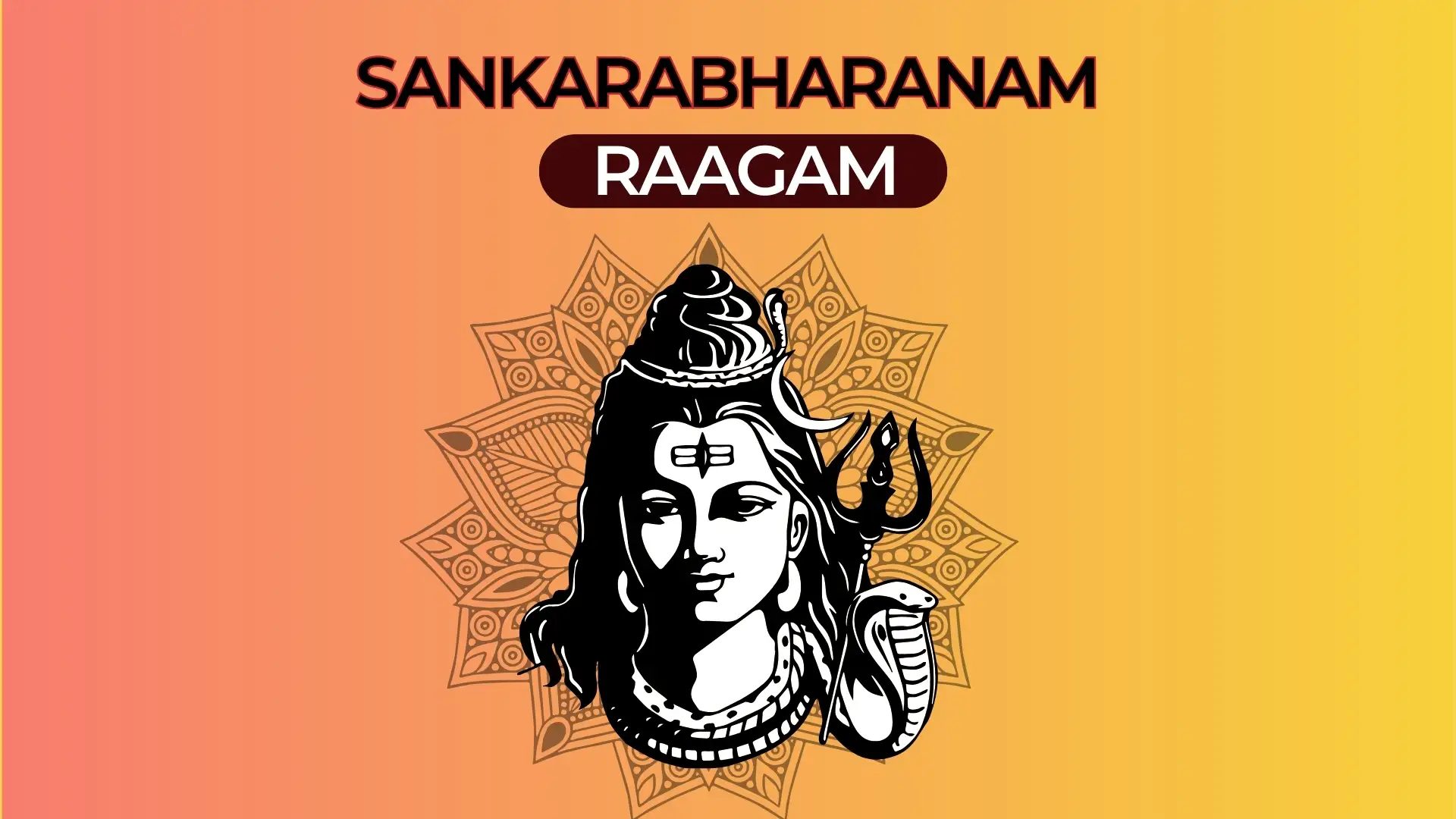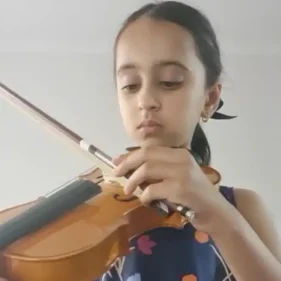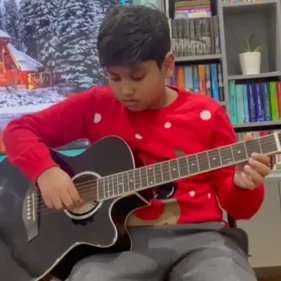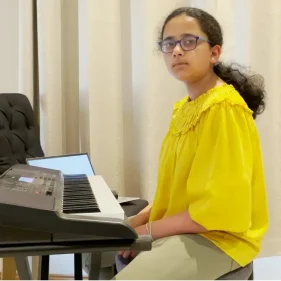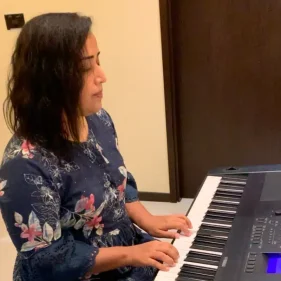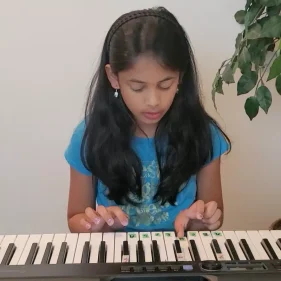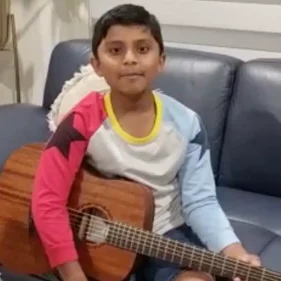- What is Sankarabharanam Raagam?
- Meaning of Sankarabharanam Raagam
- Historical Background and Origin of Sankarabharanam Raagam
- Characteristics of Sankarabharanam Raagam
- Sankarabharanam Ragam in Carnatic Music
- Sankarabharanam Ragam Equivalent in Western music
- Sankarabharanam Ragam Famous Compositions
- How is Sankarabharanam Raagam utilized in classical music compositions?
- FAQs
Sankarabharanam Raagam, (Shankarbharanam or Dhirashankarabharanam) holds the position, among the 72 melakarta ragas in music. It is a vibrant raga that encompasses ornamentations called Gamakas.
Sankarabharanam Raagam is a raga which uses of all seven notes in both ascending and descending patterns.
Interestingly Natabhairavi, the Melakarta raga includes Sankarabharanam as one of its components. Often hailed as the “king of ragas’ ‘ Sankarabharanam holds significance in music and serves as the starting note for all Melakarta ragas.
This article delves into the background distinguishing characteristics and noteworthy compositions associated with Sankarabharanam in music.
What is Sankarabharanam Raagam?
Sankarabharanam exudes a tranquil and soothing essence. Represents the C Major scale in Western classical music. In the Hindustani music system the ‘Sankarabharanam’ scale corresponds to ‘Bilaval’ scale with regard to pitch range.
This raga evokes a sense of regality and grandeur while being widely recognized within music for its qualities that induce relaxation in listeners. The tempo of songs based on Sankarabharanam typically varies between medium pace depending on the composition.
As a raga the singing always commences with Sankarabharanam Raagam. It serves as an opening melody holds a place, in temples and religious ceremonies.
The musical notes that constitute the Sankarabharanam raga are Sadja, chatusruti rishaba, Antara Gandhara, madhyama, panchama, chatusruti dhaivata and kakali nishadam.

Sankarabharanam Ragam; Where each note tells a story evoking emotions through melodies that surpass boundaries and touch the soul with timeless beauty.
Meaning of Sankarabharanam Raagam
Sankarabharanam holds a place, in music the classical music of South India. It derives its name from the union of “Sankara,” representing Lord Shiva and “Bharanam ” signifying adornment. This melodic ragam is highly regarded for its appeal. Serves as an ideal foundation, for beginners venturing into the realm of Carnatic music.
Historical Background and Origin of Sankarabharanam Raagam
Sankarabharanam stands as one of the revered ragas, in Carnatic music tradition. It invokes a sentiment known as Sringara Rasa, which emanates from the love for Lord Vishnus dance form called “multiplier” and Bhakti rasa, which refers to the religious sentiment associated with devotion to God or goddess.
The tranquility brought forth by this melody is akin to a rock just like how our devotion transforms it into an artistic masterpiece!
The five musical notes of Sankharabharanam. R, G, M D N. Reflect the nature of Lord Shiva; Satyojatham (the one) Thathurusham (stability) Eesaananam Sankaram (auspiciousness) Vaamadevam (the left handed one) and Aghoram (the fearless one).
The notes Sa and Pa are like elements in this raga. These seven sounds are symbolic of adornments worn by Lord Shiva.
The raga is also mentioned in the Sangeetha Ratnakaram, where it is described as a delightful deity with skin adorned with ashes or sacred vibhoothi on its forehead. Serpents grace this beings appearance of Lord Shiva in his traditional form.
The seven musical notes of a Raga correspond to ornaments worn by Lord Shiva. The first note represents Sa. Symbolizing the serpent; followed by R. Representing the Rudraksha flower that he holds in one hand while granting boons; G. Symbolizing the holy Ganga flowing atop his head Siva, adorned with his deer companion Mriga by his side carries the Pasupatha, his weapon, slung across his back.
In one hand he holds the Damaru Sivas drum, while on his head rests Nagendra, the king of snakes. Each of these elements symbolizes aspects or avatars of Lord Shiva.
The Sankarabharanam scale has a presence. In Tamil music it was referred to as Pann Pazhampanjuram. Hindustani musicians call it by the name Bilaval. In Western music theory it is known as C Major.

Did You Know?
Sankarabharanam Ragam, a majestic raga, in music is often called the “Janaka Raga”. This term implies that it is the father or originator of ragas. It’s fascinating to note that over 300 ragas have evolved from the structures of Sankarabharanam highlighting its influence and importance, in Indian classical music.
Characteristics of Sankarabharanam Raagam
Sankarabharanam raagam is distinguished by its use of gamakas or melodic embellishments on notes. These gamakas play a role on the rishaba (second scale degree). Sadja nishada dhaivata (seventh, ninth and tenth scale degrees).
Alongside gamakas, Sankarabharanam is renowned for its ornamentation on the sadja nishada dhaivata sequence. This results in a sound that defines the essence of Sankarabharanam raagam. Notably it exhibits a landing. Lingers on the Gandhara note for some time.
The close association of Sankarabharanam with music contributes to its identity among other ragas.
Sankarabharanam Ragam in Carnatic Music
Sankarabharanam, is a prominent ragam in the tradition of music. It holds a place within the melakarta system as the 29th ragam, distinguished by its ascent (arohanam) and descent (avarohanam); Sa, Ri2, Ga3, Ma1 Pa, Dha2, Ni3, Sa.
Sankarabharanam Ragam Equivalent in Western music
Although Carnatic music and Western music follow scales and systems there are parallels that can be drawn. The unique intervals of Sankarabharanams scale bear some resemblance to music. Its notes align somewhat with the scale making it relatable to Western musical sensibilities.
In essence Sankarabharanam Ragam holds a position in music due to its emotive depth, intricate structure and its ability to evoke a multitude of emotions. It remains a source of inspiration, for artists and enthusiasts alike by captivating hearts with its charm and timeless compositions.
Discover the beauty and spiritual depth behind the lyrics of ‘Maha Ganapathim‘. Dive into the meaning and cultural significance of this revered hymn dedicated to Lord Ganesha.
Sankarabharanam Ragam Famous Compositions
Sankarabharanam has been an inspiration for composers who have created numerous masterpieces in Carnatic music. Timeless compositions like Tyagarajas “Brochevarevarura” and Annamacharyas “Nagumomu” beautifully exemplify the depth and versatility of this ragam. Here is a famous Sankarabharanam Geetham’s swara and sahithyam.
Raga: Sanakarabaranam
Tala: Aadi
Aro: S R2 G2 M1 P D2 N2 S
Ava: S N2 D2 P M1 G2 R2 S
| S | , | , | R | G | , | M | , | P | , | , | , | P | , | , | . | | | |||
| Sya | – | – | ma | le | – | mi | – | na | – | – | – | Kshi | – | – | – | | | |||
| D | , | , | N | Ṡ | , | Ṡ | N | | | D | , | P | , | M | , | G | , | || | ||
| sun | – | – | da | re | – | sva | ra | | | sa | – | – | – | Kshi | – | – | – | || | ||
| M | , | D | , | M | , | R | , | G | , | P | , | G | , | S | , | | | |||
| San | – | ka | – | ri | – | gu | – | ru | – | gu | – | ha | – | sa | – | | | |||
| R | , | M | , | R | , | Ṇ | , | | | S | , | , | , | S | , | , | , | || | ||
| mud | – | bha | – | ve | – | si | – | | | ve | – | – | – | va | – | – | – | || | ||
| P | , | , | , | P | , | P | , | M | , | , | , | M | , | M | , | | | |||
| pa | – | – | – | ma | – | ra | – | mo | – | – | – | cha | – | ni | – | | | |||
| G | , | , | , | G | , | G | , | | | R | , | , | , | R | , | R | , | || | ||
| pan | – | – | – | ka | – | ja | – | | | lo | – | – | – | cha | – | ni | – | || | ||
| P | , | , | , | P | , | D | P | M | , | , | , | M | , | P | M | | | |||
| pa | – | – | – | dma | – | sa | na | va | – | – | – | ni | – | ha | ri | | | |||
| G | , | , | , | G | , | M | G | | | R | , | , | , | R | , | G | R | || | ||
| la | – | – | – | ksh | mi | vi | nu | | | te | – | – | – | sam | – | bha | vi | || |
How is Sankarabharanam Raagam utilized in classical music compositions?
Carnatic music frequently incorporates the structure of Sankarabharanam, in its compositions. Esteemed composers such as Muthuswami Dikshitar, Thyagaraja, Swathi Thirunal and Mysore Vasudevachar have all utilized Sankarabharanam raagam, in their creations.
Notable pieces include Maharaja Swathi Thirunals Adathaalavarnam written in Telugu and Swathi Thirunals Nrityati Nrityati composition.
Other famous compositions by Muthuswami Dikshitar in Sanskrit include Dakshinamurte, Sadasivam Upasmahe, Akshayalimgavibho and Sri kamalamba. In Kannada notable works are Pogadirelo Ranga (part of the Navaratna Malike) Kande naa kanasinali and Enagu aane by Purandara Dasa.
Kanaka Dasas contribution includes Yenu Olle Hariye. Additionally Syama Sastri composed SarojadalaNetri and Devi Minanetri in Telugu.
Muthuswami Dikshitar is credited with creating 22 “NottuSwara” pieces based on the notes of the Western Major Scale. These pieces have gained popularity. Have become a valuable addition to any playlist.
Sankarabharanam raagam is frequently used in film music, in Tamil cinema. Some of the songs in this raagam include “Enthara Enthara,” “Kadhal Rojave,” “Muthu Muthu,” and “Rama Rama.”
Prominent Carnatic musicians such as M. S. Subbulakshmi, Balamuralikrishna and K. J. Yesudas have performed compositions in Sankarabharanam.
In conclusion, among music enthusiasts the Sankarabharanam raagam holds popularity as it can be enjoyed by musicians at all levels of expertise. If you are new to music or simply seeking relaxation after a day starting with Sankarabharanam is an excellent choice.
Sign up for the online carnatic music classes today. Dive into the mesmerizing world of Sankarabharanam raagam!
[TABS_R id=13370]
FAQs
What is the significance of the Sankarabharanam ragam?
Sankarabharanam ragam holds a special place in music as a melodious raga often referred to as the “mother of ragas.” It serves as a framework for compositions and improvisations.
Is Sankarabharanam ragam considered a raga?
Absolutely! Sankarabharanam ragam is highly esteemed as a raga in music.
What are the distinctive features of Sankarabharanam ragam?
The notable characteristics of Sankarabharanam raga lie in its seven note octave emphasizing intervals while avoiding semitones.
How is the scale and structure of this raga defined?
In music ragams are frameworks that encompass scales and structures comprising specific ascending (Arohanam) and descending (Avarohanam) patterns of musical notes.
Are there any exercises or techniques I can use to practice this ragam?
Engaging in exercises and immersing yourself in the melodies of this raga through attentive listening and imitation can be effective methods for practicing it.
Can you provide some tips for singing in Sankarabharana ragam?
To excel in singing Sankarabharana ragam focus on mastering the patterns, pay attention to elongating notes and infuse your rendition with depth.
Which kritis or devotional songs are choices for performances, in this ragam?
Some chosen kritis and devotional songs, for concerts, in this ragam include ‘Endaro Mahanubhavulu’ and ‘Bhavayami Gopalabalam’.
Related Blog: Meaning of Geethas

